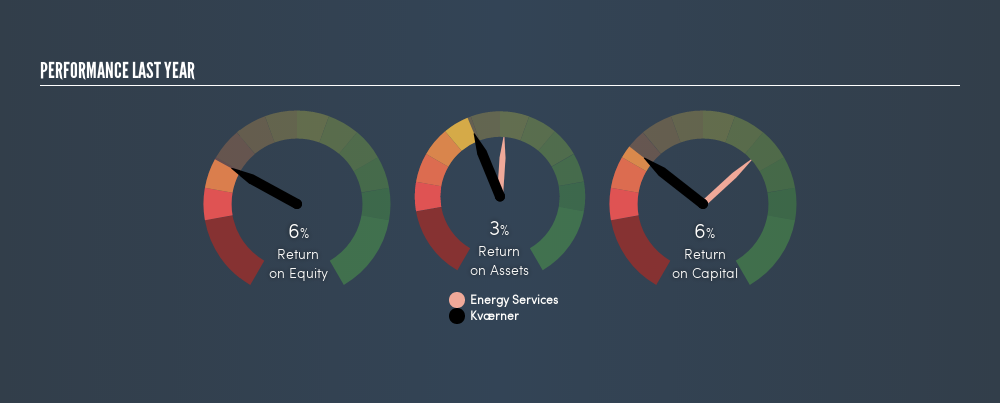
Want to participate in a short research study? Help shape the future of investing tools and you could win a $250 gift card!
Today we'll look at Kværner ASA (OB:KVAER) and reflect on its potential as an investment. To be precise, we'll consider its Return On Capital Employed (ROCE), as that will inform our view of the quality of the business.
First, we'll go over how we calculate ROCE. Then we'll compare its ROCE to similar companies. And finally, we'll look at how its current liabilities are impacting its ROCE.
Return On Capital Employed (ROCE): What is it?
ROCE measures the 'return' (pre-tax profit) a company generates from capital employed in its business. All else being equal, a better business will have a higher ROCE. Ultimately, it is a useful but imperfect metric. Author Edwin Whiting says to be careful when comparing the ROCE of different businesses, since 'No two businesses are exactly alike.'
So, How Do We Calculate ROCE?
The formula for calculating the return on capital employed is:
Return on Capital Employed = Earnings Before Interest and Tax (EBIT) ÷ (Total Assets - Current Liabilities)
Or for Kværner:
0.058 = øre244m ÷ (øre6.8b - øre2.6b) (Based on the trailing twelve months to March 2019.)
Therefore, Kværner has an ROCE of 5.8%.
See our latest analysis for Kværner
Is Kværner's ROCE Good?
When making comparisons between similar businesses, investors may find ROCE useful. We can see Kværner's ROCE is meaningfully below the Energy Services industry average of 7.4%. This could be seen as a negative, as it suggests some competitors may be employing their capital more efficiently. Separate from how Kværner stacks up against its industry, its ROCE in absolute terms is mediocre; relative to the returns on government bonds. It is possible that there are more rewarding investments out there.
Kværner's current ROCE of 5.8% is lower than its ROCE in the past, which was 18%, 3 years ago. This makes us wonder if the business is facing new challenges.

When considering ROCE, bear in mind that it reflects the past and does not necessarily predict the future. ROCE can be deceptive for cyclical businesses, as returns can look incredible in boom times, and terribly low in downturns. ROCE is only a point-in-time measure. Remember that most companies like Kværner are cyclical businesses. Since the future is so important for investors, you should check out our free report on analyst forecasts for Kværner.
Kværner's Current Liabilities And Their Impact On Its ROCE
Liabilities, such as supplier bills and bank overdrafts, are referred to as current liabilities if they need to be paid within 12 months. The ROCE equation subtracts current liabilities from capital employed, so a company with a lot of current liabilities appears to have less capital employed, and a higher ROCE than otherwise. To check the impact of this, we calculate if a company has high current liabilities relative to its total assets.
Kværner has total assets of øre6.8b and current liabilities of øre2.6b. As a result, its current liabilities are equal to approximately 38% of its total assets. Kværner's middling level of current liabilities have the effect of boosting its ROCE a bit.
What We Can Learn From Kværner's ROCE
With this level of liabilities and a mediocre ROCE, there are potentially better investments out there. But note: make sure you look for a great company, not just the first idea you come across. So take a peek at this free list of interesting companies with strong recent earnings growth (and a P/E ratio below 20).
I will like Kværner better if I see some big insider buys. While we wait, check out this free list of growing companies with considerable, recent, insider buying.
We aim to bring you long-term focused research analysis driven by fundamental data. Note that our analysis may not factor in the latest price-sensitive company announcements or qualitative material.
If you spot an error that warrants correction, please contact the editor at editorial-team@simplywallst.com. This article by Simply Wall St is general in nature. It does not constitute a recommendation to buy or sell any stock, and does not take account of your objectives, or your financial situation. Simply Wall St has no position in the stocks mentioned. Thank you for reading.
Market Insights
Community Narratives





